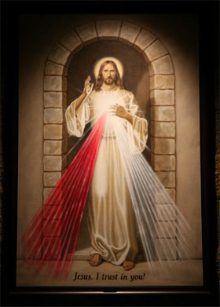
Adoration
We are pleased with the addition of an easy to use software program to schedule your Adoration hours in the chapel.
Whenever Jesus is exposed in the monstrance we are required to have at least 2 people in attendance, no matter the time of day or night. In order to fulfill that obligation, we need people to commit to an hour on a regular basis. If you are not able to commit on a regular basis, we are also in need of substitutes.
This simple program allows you to schedule yourself for prayer time in the chapel. You may sign up for a regularly scheduled time, but even if you are unable to commit to a regular weekly or monthly commitment, We Adore Him allows you to schedule a one-time visit (of course, our chapel is always available to you without scheduling a time).
Visit this website to schedule: www.stanastasiaweadorehim.com/en
You can also call Lisa Harrison to schedule your time, ask questions, or to offer your assistance. She may be reached by phone at (248) 689-8380 ext. 109.
About our Chapel of Divine Mercy
The Divine Mercy Chapel was added to our church in 2006 to give people a quiet place to pray without interruption.
The Eucharistic presence of our Lord Jesus will always be there, as indicated by the light burning next to the tabernacle. The chapel has rough stone walls to remind us of the cave where the Lord was born, and also rough wooden beams across the top, oversize wooden borders around the windows, and an oversize wooden door to remind us of the manger.
The chapel is designed in the shape of an octagon, or rather, five-eighths of an octagon. The early Christians often constructed their baptisteries in an octagonal shape (a baptistery was a separate building in those days, not like the little fonts that we so often see today!). This shape is not by chance. The number eight is connected to the resurrection, because the day Jesus rose from the dead, the day of the Sabbath, was thought to be “the eighth day of the week.”
There are two niches on the west side. In one niche is the book of Scriptures, with a golden cover to remind us of the dignity that is to be accorded to the Word of God, and in the other niche is a tabernacle. Under the niche that contains the Scriptures is an inscription that reads, “In the beginning was the Word” (from John 1:1). Under the tabernacle is an inscription that reads, “And the Word became Flesh” (from John 1:14). And, centrally, underneath the Divine Mercy image, is an inscription that reads, “And dwelt among us” (also from John 1:14).
In the front of the chapel, there is a painting of the Divine Mercy image, with red and white rays coming from the heart of Jesus, indicating the blood and water which flowed forth at His death on the cross.
The stained glass window is the icon of our patroness. Anastasia, as we mentioned, is mentioned in the Roman Canon of the Mass, and, while few of the details of her life are known, we can put together a rough outline of her life.
Anastasia was a Christian woman who lived in the eastern part of the Roman Empire. She was married to a non-Christian man (and thus is immediately a great intercessor for those marriages which are often called “unequally yoked” – i.e., one spouse has great faith, and the other has little or none). She dedicated herself in heroic fashion to the care both of the sick among the Christians, and to the care of those who were imprisoned and condemned to die by decree of the Empire. Anastasia finally is martyred herself for these acts of love, and is burned alive.
There is a statue of Our Lady of Guadalupe with candles around her. Our Lady of Guadalupe is the patroness of The United States of America, and indeed of the whole of the Americas. She is also the patroness of the innocent lives of children, especially of those who are in danger of not being born. That statue is also made in northern Italy, and will not only serve as a constant reminder of the maternal prayers of the Mother of God for us, disciples of her Son, but a spur for us all to constantly ask her intercession for the peoples of the Americas and for the unborn in a special way.
The pews in the chapel come from Our Lady, Help of Christians, on MacDougal in downtown Detroit. This Church has recently closed and is being converted into a place of worship for the Muslims. We hope the pews will be a constant reminder of our solidarity with the people of the inner city, for whom so many people here give generously of their time and treasure.
On the threshold of the door, imbedded into the stained concrete floor, is a piece of the floor from St. Peter’s Basilica in Rome. On the back wall of the chapel is a relief of scenes from Saint Anastasia’s life, and near it is a cross brought back from Assisi, Italy, years ago by Fr. Ken Kaucheck.
